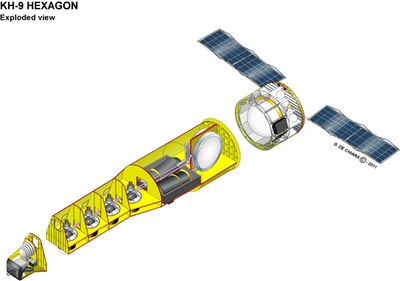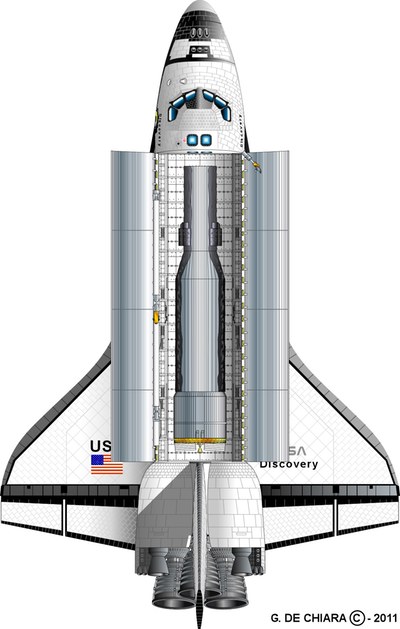The HEXAGON and the Space Shuttleby Dwayne A. Day
|
| If the HEXAGON led to the requirement for the payload bay length, it probably would not have fit, unless the mapping camera was removed. |
As just about everybody who is familiar with the origins of the space shuttle knows by now, it was a shotgun marriage. NASA agreed to adapt the shuttle design to make it capable of launching Department of Defense satellites, and in return the DoD—essentially the Air Force, also speaking on behalf of the National Reconnaissance Office, which manages intelligence satellite programs—agreed to support the shuttle. One of the frustrating aspects of history is that it is rarely neat, and it is therefore necessary to unpack the sequence of events, some of which are clear and concise and others which are not. Figuring out just when and how military requirements factored into shuttle decisions has always been somewhat frustrating, largely because those requirements remain classified even forty years later.
What we do know is that several military requirements drove the initial shuttle design. One was the requirement for the ability to fly large distances during reentry, something that was vital if a shuttle was going to be launched into the militarily attractive polar orbit and then had to chase down the American west coast as it rotated away underneath. That dictated the shuttle’s relatively large delta wings.
The military also had the requirement to launch relatively heavy payloads into difficult orbits, and in the late 1960s the hefty HEXAGON, weighing in at 13,600 kilograms (30,000 pounds), was the heaviest satellite then under construction. The shuttle’s payload bay width was also driven by a military requirement, although this one is tricky—the requirement was dictated by the need to carry large intelligence satellites to geosynchronous orbit, and getting them there necessitated a powerful cryogenic upper stage. Cryogenic means liquid hydrogen and oxygen, and hydrogen takes up space, meaning that the shuttle payload bay had to be wide enough to accommodate a wide hydrogen upper stage, as well as long enough to fit a substantial satellite in front of it. But the payloads the intelligence community was planning on building that might dictate that requirement remain classified.
The shuttle payload bay’s length remains a mystery. The HEXAGON’s maximum length was 18.3 meters (60 feet), give or take a few inches, pretty much the same length as the shuttle payload bay. But this was with the mapping camera attached at front, and it left almost no wiggle room inside the payload bay. If the HEXAGON led to the requirement for the payload bay length, it probably would not have fit, unless the mapping camera was removed. (See Giuseppe De Chiara’s illustration of the HEXAGON without a mapping camera inside the shuttle bay to see how little room was left.)
However, the relationship could work both ways: intelligence satellite requirements influenced the shuttle design, but the shuttle could also have an impact upon those intelligence satellites as well.
 An expanded view of a KH-9 HEXAGON satellite. (credit: © Giuseppe De Chiara) |
Reusable Big Bird
On September 17 the National Reconnaissance Office declassified the HEXAGON satellite program, which for many years had been euphemistically referred to as the “Big Bird.” In addition to displaying a ground test vehicle and releasing photographs, the NRO also declassified several substantial histories about that program filled with extensive details. This declassified material sheds a little more light on the interaction of national intelligence requirements on the shuttle—but unfortunately, it’s more like the light from a 40-watt bulb than a blazing searchlight.
| For resupply and maintenance the HEXAGON would have had to be hard-docked to the shuttle and astronauts in spacesuits would have had to conduct the repairs and resupply, presumably in similar ways to the Hubble servicing missions that followed two decades later. |
The HEXAGON was a massive reconnaissance satellite, sixty feet long and weighing 30,000 pounds. The first one was launched atop a Titan IIID rocket in summer 1971, and the twentieth and last one blew up over its launch pad in April 1986. HEXAGON had two powerful cameras that swept back and forth as it flew along in its orbit, scanning images onto long strips of film that whipped through the camera system at lightning speed before being collected in four separate reentry vehicles that parachuted back to earth and were captured in midair northwest of Hawaii. The HEXAGON was a technological marvel, undoubtedly the most sophisticated robotic spacecraft of its day.
According to a declassified HEXAGON history, in January 1972 Lockheed Missiles and Space Company and camera contractor Perkin-Elmer concluded a study of HEXAGON’s compatibility with the shuttle. The goal of that study had been to determine “the minimum modifications required” to make it and its supporting ground equipment and facilities compatible with the shuttle. Another goal was to calculate the incremental costs of making these modifications.
The contractors evaluated two different operating modes for the HEXAGON. The first was simply using the shuttle as a booster to put the big satellite in orbit. The second option they studied was to both launch and retrieve the spacecraft via shuttle. The HEXAGON would be refurbished after flight for another launch.
Although the details of these studies have not been released, they undoubtedly considered things such as the launch environment for the spacecraft as well as how it would be mounted in the shuttle bay and retrieved at the end of its mission. For example, the HEXAGON’s solar panels probably would have had to be jettisoned before the spacecraft could be retrieved and brought back inside the payload bay. Either that or they would have to be completely redesigned to be retractable. Other systems would have had to be made compatible with shuttle safety requirements, and the big satellite would have had to be equipped with capture targets for the shuttle’s arm. Titan and shuttle launches were different experiences for satellites—payloads on Titans had to rest on their bases, whereas those in the shuttle were gripped from their sides. Acoustic environments were also different, and it would have been necessary to determine how the different shaking and noise would have affected the spacecraft’s precise optics and other systems. Still, the big satellite was obviously no delicate flower, and looks like it probably would have required few structural modifications for shuttle flight.
In 1973, the NRO had the contractors do a second, more ambitious study. This time they were asked to look at three different operational concepts. The first was resupply: using the shuttle to replace a HEXAGON satellite’s expendables while in orbit. The second option was maintenance: replacing failed or life-limited items in orbit. The last operational concept was returning the satellite to earth for refurbishment for future flight.
The baseline assumption for this study was two missions per year, each operating a minimum of 120 days, with the first launch taking place from Vandenberg Air Force Base in California in 1982. The economic model was based on the assumption that the HEXAGON program would operate until 1992.
Each expendable HEXAGON was equipped with four reentry vehicles that returned its film to earth. Starting with the fifth mission, the spacecraft was equipped with a dedicated mapping camera with its own smaller reentry vehicle. One of the major aspects of the study was that the size, type, and quantity of reentry vehicles for the shuttle version could be altered, meaning that a shuttle variant could be significantly different than the version that was already flying in the early 1970s.
The resupply and maintenance study assumed that the spacecraft would be equipped with “space replacement units” and would also be capable of being resupplied with both fuel and gas for the pressurization system. In order to prevent the film from drying out and cracking, the HEXAGON kept the entire film path pressurized with nitrogen, and this would have to be resupplied. Approximately half of the HEXAGON vehicle’s weight was expendables: fuel, reentry vehicles, and film, so any refurbishment and refueling in orbit was a major effort.
| The study concluded that the least expensive option would be to simply capture the spacecraft and bring it back down for refurbishment. After all, in 1973 shuttle launches were still supposed to be cheap. |
For resupply and maintenance the HEXAGON would have had to be hard-docked to the shuttle and astronauts in spacesuits would have had to conduct the repairs and resupply, presumably in similar ways to the Hubble servicing missions that followed two decades later. But the program history noted that later experience with designing the Hubble Space Telescope for astronaut servicing demonstrated the limitations of on-orbit servicing. Astronauts in bulky spacesuits had limited maneuverability and the equipment they used had to be designed for safety. Therefore, it might not have been possible to perform all of the desired or necessary work on an orbiting HEXAGON. One major difference between Hubble and HEXAGON was that astronauts could service Hubble primarily by replacing units in its base, but refurbishing a HEXAGON meant installing four new reentry vehicles along the forebody of the spacecraft, as well as replacing fuel in its stern and a massive new film supply forward of the fuel tank. Once all of this was done, the film path would have had to be repressurized. It would have been a formidable engineering challenge.
One thing that the study did not explore very deeply was the difficulty of replacing the 3,310 kilograms (7,300 pounds) of film in space. Certainly it would have been contained in large resupply cartridges, but would it be possible to redesign the system so that this film could be properly oriented to spool through the camera system and into the reentry vehicles, and then have all pressurization interfaces re-sealed? That was hard enough to do on the ground, by hand, let alone automatically in a zero-g environment.
According to the study, developing the special kits for satellite servicing, the shuttle-mounted equipment, and configuring the spacecraft for resupply and maintenance, would be the biggest costs. This is not surprising. According to one former astronaut who performed an important Hubble servicing mission, NASA spent a significant amount of money on Hubble simply making it safe for humans to operate on, as well as building high-fidelity mockups on the ground for astronaut training. Unlike Hubble, HEXAGON was not originally designed without sharp edges that could cut a spacesuit, or with handholds for spacewalking astronauts. Those features would have to be added and tested, and they would have cost money.
The study concluded that the least expensive option would be to simply capture the spacecraft and bring it back down for refurbishment. After all, in 1973 shuttle launches were still supposed to be cheap.
HEXAGON 1980s
According to the history, the HEXAGON reusability concept resurfaced nine years later when Major General John Kulpa, director of the Air Force component of the NRO, initiated new studies in 1982. This time Kulpa included several shuttle astronauts in the studies. By then the HEXAGON was scheduled for retirement and Kulpa was apparently motivated to see if it would be possible to recover the last two vehicles then planned for launch, refurbish them, and relaunch them, extending the lifetime of the program. Significantly, Kulpa suggested that the spacecraft be launched from the Kennedy Space Center into polar orbits. This would have required the shuttles to launch on northbound trajectories, and drop their solid rocket motors over Cleveland, Ohio, presumably to splash down in Lake Erie and hopefully not impact in Canada.
Kulpa’s proposal was never implemented and the last HEXAGONs flew on Titans and were deorbited into the Pacific Ocean, except for the final vehicle, which was destroyed when its Titan blew up. By this time the HEXAGON’s duties had been assumed by other spacecraft. They too had a complex, and not always congenial, relationship with the space shuttle. But that’s another story.
